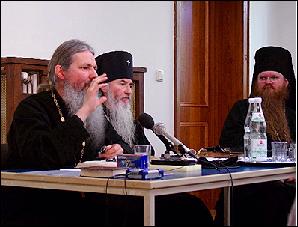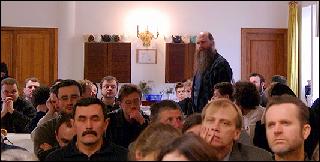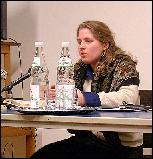|
XXI Orthodox Conference in Munich
The Annual Orthodox Conference was held at the Cathedral of
the New Martyrs and Witnesses of Russia and St. Nicholas from
26-28 December, in which over a hundred people participated.
As has been the custom, the Conference began with a service
of supplication. It was conducted before a large Icon of St.
Nicholas, which was painted in its time by order of the New
Martyr, the Duchess St. Elizabeth Fyodorovna for the church
of St. Alexander Nevsky in the Holy Land.
Now it has been temporarily given from the bequeathment of
the daughter of the famous composer Alexander Glazunov, Elena.
E. Glazunova lived not far from the cathedral and was buried
literally right beside it, 50 meters away in the nearby cemetery.
The mother of E. Glazunova became a nun in the Holy Land after
the death of her husband. In 1948, after the collaboration
between Israel and the USSR, church property came into the
possession of the Soviet government, some nuns saved many
of the holy items, among them this icon of St. Nicholas. It
has been kept since by the Jerusalem Patriarchate. The Patriarch
of Jerusalem gave the icon to the former benefactor of monastics
in the Holy Land, now nun Alexandra (Glazunova), who also
received a cell at the church of the Resurrection of Christ.
In 2003, the icon of St. Nicholas the "Consoler,"
was by bequeathment to be given to one of the Carpathian monasteries.
(Photo: Protopriest Nikolai Artemoff, Archbishop Mark and
Bishop Agapit.)

The first lecture, on the Seventh Ecumenical Council, was
read by Archbishop Mark. Clarifying at the outset that a Council
is considered Ecumenical whose decisions are accepted by the
entire Catholic (Universal) Orthodox Church, Vladyka concentrated
on the history of the Iconoclastic movement and the essence
of the theological debates of the time on the veneration of
icons. Iconoclasm was based, on one hand, on the speculative
imaginings on the indescribability of Divinity, and on the
other hand: on those superstitions and abuses that existed
with regard to icons. The Fathers of the Council determined
in their "oros" that the veneration of icons was
based on the Traditions of the Church, and that a inarguable
prototype of the veneration of icons was the veneration of
the True and Life-Giving Cross. Veneration imparted to an
icon rises to its First-image, the image of the Lord, the
God-Man Jesus Christ and His saints. Materials were indicated
for the painting of icons, and the circle of individuals to
be depicted by them as well: the Lord Jesus Christ, the Mother
of God, the holy angels and the saints.
The goal of the veneration of icons of saints, as the Fathers
of the Seventh Ecumenical Council saw it, was for the faithful,
through frequent beholding and veneration of icons, would
recall the acts and works of the saints and would imitate
them. Vladyka pointed out to the audience that today, as in
ancient times, one comes across superstitions about the veneration
of icons, so pastors must teach their flocks the correct and
beneficial attitude the holy icons and holy relics.
Another important question the Fathers of the Council had
to address was the question of bishops who took part in the
Iconoclastic persecutions. Vladyka detailed how the repentant
iconoclasts were once again received into communion in their
existing rank, and, as a rule, were left on those same cathedras
which they occupied. Archbishop Mark noted that the thought-out
reasoning of this experience in the spirit of the Holy Fathers
may help in the resolution of similar problems, which could
arise of the present movement to achieve unity among the sundered
parts of the Russian Church would further develop in that
direction.
Upon the end of the lecture, vespers commenced, conducted
by Priest Dimitry Kolachev. Archbishop Mark, Protopriest Nikolai
Artemoff and Priest Sergei Kisilev took confessions. Many
took advantage of the opportunity to partake of the Mystery
of Confession.
As always during these Conferences, all the services were
held in the Cathedral. The physical nourishment of the conferees--breakfast,
lunch and dinner--was tended to by the local Sisterhood.
The next day, Friday 27 December, matins began at 6 a.m.,
before sunrise, as Church rule stipulates, in a half-darkened
church, illuminated by a few candles. Liturgy, conducted by
Archbishop Mark along with Protopriest Nikolai Artemoff and
Priests George Seide and Dimitrii Kolachev, had many people
partake of Communion.
After breakfast, Prof. Alexander Gavrilin of Riga gave a lecture
on the state of the Orthodox Church in Latvia and Estonia.
The participants of the conference first viewed a film brought
by the lecturer, who then showed charts displaying the development
of Church life in the Baltics, and finally gave a voluminous
description of the contemporary situation.

After lunch and a recess, Archbishop Mark read a lecture entitled
"Monasticism and its Meaning for the Church." From
the very beginning, the lecturer outlined the meaning of monasticism,
saying that in the Church there were only two types of people:
- 1.
Those
who had experience in the manifesting of the Gospel into
life. These people reject wealth, human glory, unnatural
pleasures of this world, and submitted to the guidance of
more experience teachers, and
- 2.
those who did not experience this, but respecting those
who do. This respect and love make such people participants
in the Truth. Those who are outside of these categories
place under question their belonging to the Church.
The external
form of the monastery reflects its inner state of the monk:
in the center of the monastery is the main monastery church,
around which are simple monastic residential cells. The divine
service is the point of concentration of the monastic life,
the food for the soul. But the physical nourishment in the
monastery is blessed by the divine service, the monks move
from the church directly to the refectory [trapeza], the Lives
of the Saints or other spiritual teachings are read during
the meal. The Holy Fathers of the Church saw in the monastery
where the abbot tended first of all to the spiritual success
of his brethren in Christ as an Orthodox prototype, an image
of the social life of mankind.
Vladyka explained that monasticism is a more logical attempt
to manifest the Christian ideal. Mankind, damaged by the fall
of sin, is in need of healing, and the monastery is a spiritual
hospital, where those who recognize their illness go. The
world and life led in accordanc with the world develops in
man the seed of pride: the most terrible sin, which turned
an angel into the devil and leadin man out of Eden. The monastic
life is established in such a way so that gradually, through
prayer and obedience, one may restore the original beauty
of God's creation, of which the Lord Himself said, that it
is "exceeding good."
Covering three stages of the spiritual path in turn: the cleansing
of the heart of passion, the illumination of the mind and
making it divine, the monk strives to passionlessness.
But this cannot be confused with mortifying. Passionlessness
is attained by directing one's energies to higher matters
through the "complete neglect of all evil and adhering
to all that is good." The part of the soul that feels
passion is not mortified, but transformed. After the Fall,
the part of the soul that feels passion began to operate unnaturally.
It must be redirected to the normal action by nature and above
nature. Those who reject this teaching reject the possibility
of eternal life in the body. If in the afterlife, the body
will take part along with the soul in all good, then it is
apparent that in this life it must also take part "in
blessedness given by God to the purified mind." The body
senses blessedness and participates together with the purified
mind in the divining grace of God.
That is why spiritual struggle, asceticism, repentance, humility,
tears and sorrow are vital for making man divine.
Vladyka recounted the history of monasticism (calling to mind
that in the New Testament Church, the first monk was the Forerunner
and Baptizer of the Lord John, and the first nun was the Most-Holy
Mother of God), on the different types of monasteries and
on the Munich monastery of St. Job of Pochaev, of which he
is abbot. Vladyka emphasized that there can be no complete
and healthy church life without monasticism and monasteries.
In the question and answer session, Archbishop Mark, in part,
detailed the struggle with the passion of accusation, saying
that intolerance must be first and exclusively applied to
one's own sins. If we notice the sin of our neighbor, this
means that the same sin lives in us, otherwise we would not
notice it. In judging our neighbor, we commit blasphemy, placing
ourselves in the role of God and usurping the Judgment that
belongs to God. The truly repentant prays over the granting
of sight of one's sins and has no time nor energy to notice
the sin of his neighbor. Even when the sin committed by a
neighbor is apparent, one must hate the sine, but love and
have mercy on the sinner.
After the lecture and following discussion, everyone once
again returned to church for vespers, which by the Church's
clock belongs to the next day, 15/28 December, when the Church
marks the memory of the Hieromartyr Eleutherius, Bishop of
Illyricum. Since the Munich cathedral possesses a part of
his relics, embedded in his icon, a polyeleos service was
required. Vespers were solemn, with the reading of the proper
paremii for the Hieromartyr. Matins on Saturday was led by
Archbishop Mark, along with Protopriest Nikolai Artemoff and
Priests Eugene Skopintseff, Dimitrii Kolacheff and George
Seide, and Protodeacon George Kobro. Archbishop Mark along
with the clergy emerged into the middle of the church for
the polyeleos and the reading of the Gospel. The worshipers
venerated the Hieromartyr's icon in turn, and Vladyka anointed
them with blessed eleos. As on all services during the Conference,
the choir sang under the direction of Nun Vassa (Larin). During
liturgy, almost all the worshipers partook of Holy Communion.
United church prayer and the partaking of the Mysteries is
a very important part of the Conference, since they give the
participants a living Mysterious sense of communion with the
one Body of Christ and spread this sense of Mystery to all
the Conference proceedings.
After breakfast, a lecture entitled "On Death" was
given by Protopriest Nikolai Artemoff, who has often had to
counsel the dying, sharing his experiences with people who
were on the threshold of death and who crossed to the other
side, and expounded on the Orthodox understanding of this
event in the life of man. Through the Canon on the passing
of the soul, part of which Fr. Nikolai read aloud, it is seen
how the Orthodox Church prepares Her children to the passing
into eternal life. This approach, full of holy trepidation
and utter seriousness, has nothing in common with the primitive,
consoling "rosy" picture which non-Orthodox writers
write about in various books on dying. The fear of death is
a natural fear, because death is no part of God's intention
for creation. But in contemporary society, natural fear of
death has been perverted, as have other human feelings which
are torn away from Christ. Communion with the dying is necessary
for us no less than for the dying themselves, for through
love, it relates to us, in all its reality, the experience
of dying and the defeat of death through Christ.
There were many questions for the lecturer afterwards. Among
other things, he was asked how Orthodox Christians should
view non-Orthodox practices concerning death and the afterlife
(cremation, etc.).
This discussion ran past its allotted time, and the last lecturere,
Maria Tervo of Stuttgart, was left with less time to talk
about Russian bell ringing. The bell tower in Munich was completed
not long before the beginning of the Conference, and was equipped
with 13 bells poured in Romanov-Borisoglebsk in Russia. The
Conferees, over the course of some 20 minutes, were given
the opportunity to enjoy various Russian bell-ringings under
the direction of the experienced ringer M. Tervo of Stuttgart.
(Photo: Maria Tervo.)

After lunch, topics for the next Conference were discussed,
and several participants stayed in the bell tower to study
the rudiments of Russian bell ringing. Upon the final ringing,
the 21st Annual Orthodox Conference ended with the usual parish
all-night vigil...
|